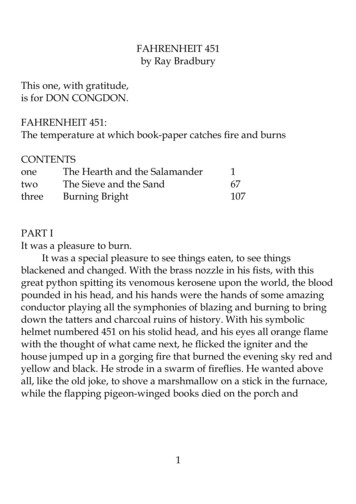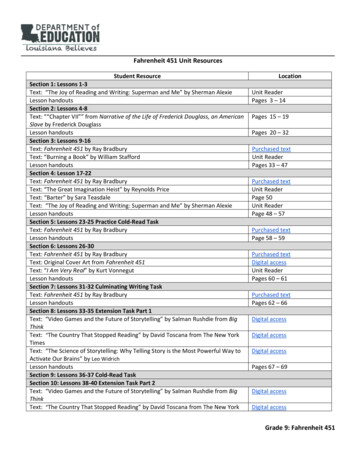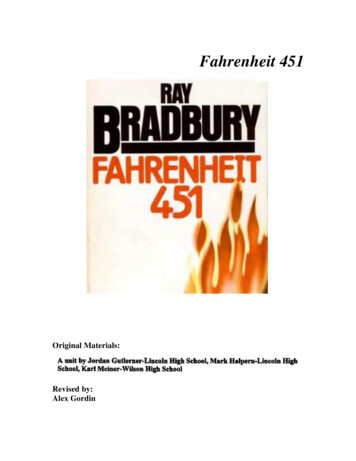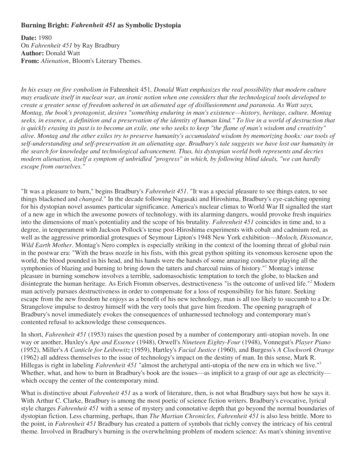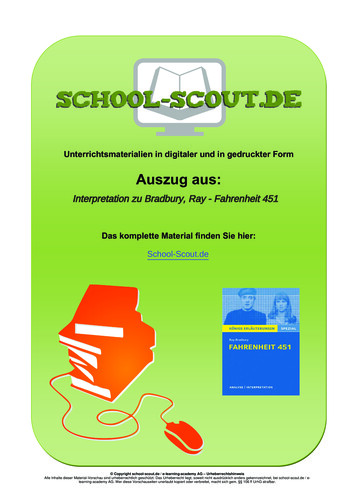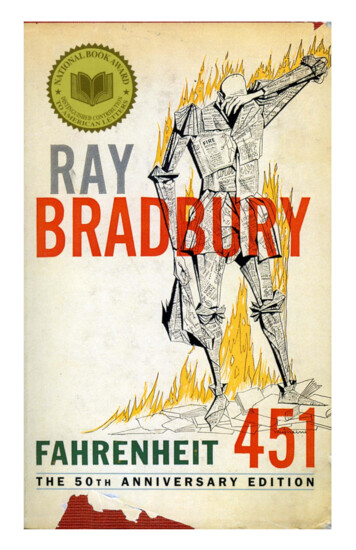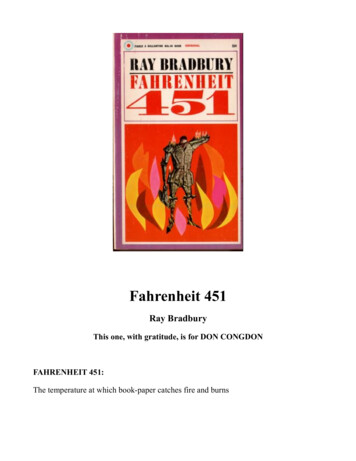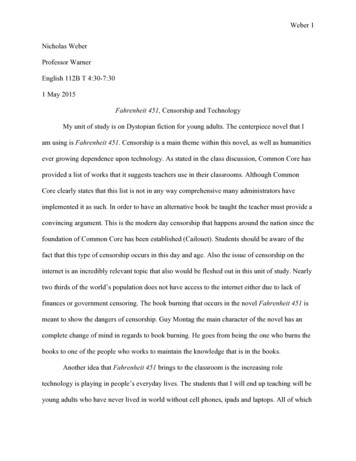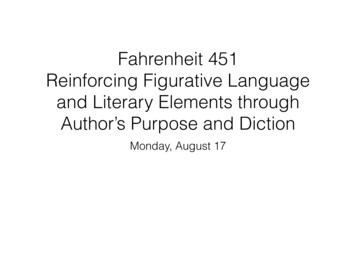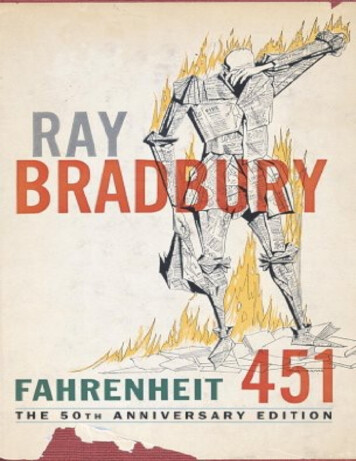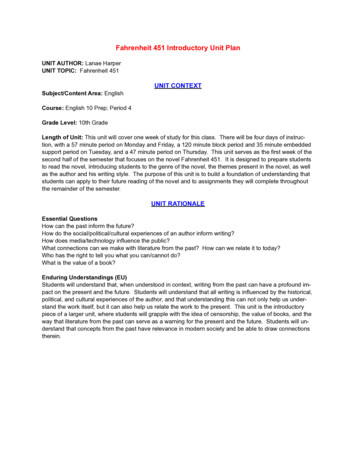
Transcription
Fahrenheit 451 Introductory Unit PlanUNIT AUTHOR: Lanae HarperUNIT TOPIC: Fahrenheit 451!!UNIT CONTEXTSubject/Content Area: English!!!Course: English 10 Prep; Period 4Grade Level: 10th GradeLength of Unit: This unit will cover one week of study for this class. There will be four days of instruction, with a 57 minute period on Monday and Friday, a 120 minute block period and 35 minute embeddedsupport period on Tuesday, and a 47 minute period on Thursday. This unit serves as the first week of thesecond half of the semester that focuses on the novel Fahrenheit 451. It is designed to prepare studentsto read the novel, introducing students to the genre of the novel, the themes present in the novel, as wellas the author and his writing style. The purpose of this unit is to build a foundation of understanding thatstudents can apply to their future reading of the novel and to assignments they will complete throughoutthe remainder of the semester.!!UNIT RATIONALEEssential QuestionsHow can the past inform the future?How do the social/political/cultural experiences of an author inform writing?How does media/technology influence the public?What connections can we make with literature from the past? How can we relate it to today?Who has the right to tell you what you can/cannot do?What is the value of a book?!Enduring Understandings (EU)Students will understand that, when understood in context, writing from the past can have a profound impact on the present and the future. Students will understand that all writing is influenced by the historical,political, and cultural experiences of the author, and that understanding this can not only help us understand the work itself, but it can also help us relate the work to the present. This unit is the introductorypiece of a larger unit, where students will grapple with the idea of censorship, the value of books, and theway that literature from the past can serve as a warning for the present and the future. Students will understand that concepts from the past have relevance in modern society and be able to draw connectionstherein.!!
UNIT STANDARDS!Content & Common Core Standards SL 1: Initiate and participate effectively in a range of collaborative discussions (one-on-one, ingroups, and teacher-led) with diverse partners on grades 9-10 topics, texts, and issues, buildingon others’ ideas and expressing their own clearly and persuasively. W 4: Produce clear and coherent writing in which the development, organization, and style areappropriate to task, purpose, and audience. RL 1: Cite strong and thorough textual evidence to support analysis of what the text says explicitly as well as inferences from the text. RI 2: Determine a central idea of a text and analyze its development over the course of the text,including how it emerges and is shaped and refined by specific details; provide an objectivesummary of the text. RL 3: Analyze how complex characters develop over the course of a text, interact with othercharacters, and advance the plot or develop the theme.!ELD Standards Collaborative ELD Standard 1, Exchanging Information/Ideas: (Bridging) Contribute to class,group, and partner discussions, sustaining conversations on a variety of age and grade-appropriate academic topics by following turn-taking rules, asking and answering relevant, on-topicquestions, affirming others, and providing coherent and well-articulated comments and additionalinformation. Collaborative ELD Standard 2, Interactive via Written English: (Expanding) Collaborate withpeers to engage in increasingly complex grade-appropriate written exchanges and writingprojects, using technology as appropriate. Productive ELD Standard 10B, Writing: (Expanding) Write increasingly concise summaries oftexts and experiences using complete sentences and key words. Structuring Cohesive Texts ELD Standard 1, Understanding Text Structure: (Expanding)Apply analysis of the organizational structure of different text types to comprehending texts.!UNIT OBJECTIVES !!Cognitive (Content Standard: SL1 & W4; ELD Standard: Collaborative 1, Emerging): Afterreading the excerpt from the Introduction to Fahrenheit 451, students will be able to predict theoverriding themes of the novel, and discuss these themes as a class. Students will be able toreflect on these themes through their writing in response to two specific prompts.Cognitive (Content Standard: RI2; ELD Standard: Productive 10B, Expanding): Students willbe able to preview an article and write a preview statement (skills from Unit One), and write asummary of an article’s main points (skills from Unit One). Students will be able to relate contentfrom a historical radio broadcast to modern society, create a group poster representing theirconnections, and present the poster to the class.Cognitive (Content Standard: RL3; ELD Standard: Structuring 1, Expanding): Students will beable to read a short story and identify elements of the plot, demonstrating their knowledge ofthese elements by completing a plot diagram.Cognitive (Content Standard: RL1; ELD Standard: Collaborative 2, Expanding): Students willbe able to use their knowledge of a text to identify the elements of its plot, demonstrating theirknowledge of these elements by completing a plot diagram. Students will work in groups to answer a series of text-dependent questions, citing specific textual references as evidence for theiranswers.
ASSESSMENT PLAN!Day 1: Discussion & Quick Write: Objective & Standard: Students will be able to predict and interpret the overriding themes of anovel, discuss these themes with others, and write about these themes in response to specificprompts. (SL 1, W 4, ELD Collaborative 1) Type: Discussion (Informal), Quick Write (Formal) Purpose: To assess students’ ability to predict and interpret themes and to respond to them verbally and in writing. Feedback Strategies: Teacher will provide written feedback. How Assessment Informs Instruction: It will assess students’ ability to reflect critically on apredicted theme or idea in discussion and in writing.!Day 2: Preview Statement/Summaries & Group Presentations: Objective & Standard: Students will be able to preview an article, write a preview statement,and write a summary of what they have read. (R1 2, ELD Productive 10B) Type: Preview Statement/Summary (Formal), Group Posters (Informal) Purpose: To assess students’ ability to preview and summarize a text, and to relate the text totheir current life experience. Feedback Strategies: Teacher will provide written feedback on Preview Statement/Summary,teacher and students will provide verbal feedback on Group advertisements/radio broadcastscripts. How Assessment Informs Instruction: It will assess students’ understanding of text’s mainideas.!Day 3: Plot Diagrams (1): Objective & Standard: Students will be able to read a short story and identify elements of theplot, demonstrating their knowledge by completing a plot diagram. (RL 3, ELD Structuring Cohesive Texts 1) Type: Informal Purpose: To assess students’ progress with the plot diagram and their understanding of the elements of a plot. Feedback Strategies: Teacher will provide written feedback. Teacher will provide verbal feedback the following class period. How Assessment Informs Instruction: This assessment will show me what students do anddo not understand with regards to the elements of a plot and guide my review for the followingday.!Day 4: Plot Diagrams (2) & Text Dependent Questions: Objective & Standard: Students will be able to use their knowledge of a text to identify elements of its plot, demonstrating their knowledge of these elements by completing a plot diagram.Students will work in groups to answer a series of text-dependent questions, citing specific textual references as evidence for their answers. Type: Both Formal; Rubric for Text-Dependent Questions provided below. Purpose: To assess students’ understanding of the elements of a plot, and to assess a studentsability to use textual references to support their answers to text-dependent questions. Feedback Strategies: Teacher will provide written feedback. How Assessment Informs Instruction: The plot diagram is something students will have tocomplete for the main text in the unit, so this assessment will give the teacher a good idea ofwhere each student is in their understanding of plot elements and their significance. The textdependent questions will help me to assess student comprehension of the text itself.
!!STEPS OF INSTRUCTIONCALENDAR:Day One (Monday): Introduction to GenreWhat is Speculative Fiction?STANDARDS:Content Standard: SL 1: Initiate and participate effectively in a range of collaborative discussions (one-on-one, in groups, andteacher-led) with diverse partners on grades 9-10 topics, texts, and issues, building on others’ ideas andexpressing their own clearly and persuasively. W 4: Produce clear and coherent writing in which the development, organization, and style are appropriateto task, purpose, and audience.!ELD Standard: Collaborative ELD Standard 1, Exchanging Information/Ideas: (Bridging) Contribute to class, group,and partner discussions, sustaining conversations on a variety of age and grade-appropriate academictopics by following turn-taking rules, asking and answering relevant, on-topic questions, affirming others,and providing coherent and well-articulated comments and additional information.!OBJECTIVES: Cognitive: After reading the excerpt from the Introduction to Fahrenheit 451, students will be able to predict the overriding themes of the novel, and discuss these themes as a class. Students will be able to reflect on these themes through their writing in response to two specific prompts.!STUDENT ACTIVITY: Anticipatory Set: Statistic: US teens and twenty-somethings check their phones an average of 49times a day (from: tatus-affects-how-many-times) Quick Write (Part 1): Students will individually write down how many times a day they personallycheck their cellphone and what they use it for. Students will work in pairs to write a short, in-class response to this question: What would our world be like today if all cell phones were outlawed? Students willshare and discuss their responses with the class. Neil Gaiman’s Introduction to Fahrenheit 451: Students will read an excerpt from Neil Gaiman’s 2013Introduction to Ray Bradbury’s Fahrenheit 451. Students will annotate the text as it is read aloud by theteacher/other students. Class Discussion: Students will discuss the introduction excerpt, and make predictions as to what thenovel will be about. Students will also discuss how the theme in the introduction can relate to a previousarticle (“Is Google Making Us Stupid? What the Internet is Doing to our Brains” by Nicholas Carr) read inUnit One. Quick Write (Part 2): Students will read the quote at the beginning of the novel: “If they give you ruled paper, write the other way” by Juan Ramón Jiménez. Students will be instructed to turn their paper sidewaysand respond (individually) to this quote, writing what they believe it means, and how they believe it will apply to the novel.!ASSESSMENT: Formative: Students will participate in a class discussion, where the teacher will formatively assess theircomprehension of the introduction and themes of Fahrenheit 451 based on their responses (informal). Summative: Students will turn in their Quick Write papers, which will serve as a summative assessment forhow well students retained the message from the day’s discussion and reading. It will also serve as a formative assessment for the unit, as it is an introduction to the themes and ideas they will be exposed to andasked to write about as the unit progresses (formal).!!!
!Day Two (Wednesday): Introduction to ThemeRegular Period: “War of the Worlds”Embedded Support: End of the World ProjectSTANDARDS:Content Standard: RI 2: Determine a central idea of a text and analyze its development over the course of the text, includinghow it emerges and is shaped and refined by specific details; provide an objective summary of the text.!ELD Standard: Productive ELD Standard 10B, Writing: (Expanding) Write increasingly concise summaries of texts andexperiences using complete sentences and key words.!OBJECTIVES: Cognitive: Students will be able to preview an article and write a preview statement (skills from Unit One),and write a summary of an article’s main points (skills from Unit One). Students will be able to relate content from a historical radio broadcast to modern society, create a group poster representing their connections, and present the poster to the class.!STUDENT ACTIVITY: Anticipatory Set: Fox News “Ebola” clips. Students will watch and discuss the effects of two mediabroadcasts about the ebola virus, and consider the effects of media on the public. “War of the Worlds” by Orson Welles: Students will listen to an excerpt of the “War of the Worlds” radiobroadcast, following along with the transcript and taking notes as they listen. Students will discuss thebroadcast with partners and as a class. “Radio Listeners Panic, Taking War Drama as Fact”: Students will read the New York Times article thatchronicles the public reaction to the “War of the Worlds” radio broadcast. Students will read the first part asa class, then jigsaw the subheadings in small groups, creating a summary and presenting vocabulary fromthe remaining article. Preview Statement & Summary: Before reading, students will preview the New York Times article andwrite a preview statement. After reading, students will write a summary of the article. Students will discussthe article with partners and as a class. Group Project: Students will create a magazine advertisement or a news report script on a current issuethat is!ASSESSMENT: Summative: Students will turn in their preview statements/summaries and they will be graded for their understanding of the text, as well as their correct usage of the preview statement/summary techniques theylearned previously in Unit One (formal). Summative (Day)/Formative (Unit): Students will demonstrate their ability to relate text and text conceptsto the real world and their current experience with the group advertisements/radio broadcasts that theypresent. Their application of a real-world example to the New York Times article will demonstrate this abilitywhen shared with the class (informal). The preview statement, summary, and poster is summative for theday’s work, as it represents their understanding of the current article. It is also formative, as it has introduced them to themes and ideas they will read and analyze further once they begin the novel.!!
!Day Three (Thursday): Introduction to Author“There Will Come Soft Rains” (Part One)STANDARDS:Content Standard: RL 3: Analyze how complex characters develop over the course of a text, interact with other characters,and advance the plot or develop the theme.!ELD Standard: Structuring Cohesive Texts ELD Standard 1, Understanding Text Structure: (Expanding) Apply analysis of the organizational structure of different text types to comprehending texts.!OBJECTIVES: Cognitive: Students will be able to read a short story and identify elements of the plot, demonstrating theirknowledge of these elements by completing a plot diagram.!STUDENT ACTIVITY: “There Will Come Soft Rains”: Students will preview and begin to read the story story by Ray Bradburypartially individually, partially in groups (the poem), and partially as a class. Elements of a Plot: Students will participate in and take notes on a review of the elements of a story’s plotand their significance to the story’s development. Plot Diagram: Students will work in groups to practice using the elements of a story’s plot by creating aplot diagram to keep track of various aspects of “There Will Come Soft Rains.” Here they will also document the development of the characters in the story and how they advance the story’s plot. Students willuse the graphic organizer from this website: (http://www.fortheteachers.org/graphic organizers.htm) seeattachment in the “Materials & Resources” section for a copy of this graphic organizer.!ASSESSMENT: Formative: Students will turn in their plot diagrams, but they will not be graded (informal). The diagramswill be informally assessed by the teacher to determine whether or not students are understanding the necessary requirements. Teacher will make notes on the plot diagrams to steer students in the right direction,and compile a list of things to review as a class on the following day.!!
!Day Four (Friday): Introduction to Author“There Will Come Soft Rains” (Part Two)STANDARDS:Content Standard: RL 1: Cite strong and thorough textual evidence to support analysis of what the text says explicitly as wellas inferences from the text.!ELD Standard: Collaborative ELD Standard 2, Interactive via Written English: (Expanding) Collaborate with peers toengage in increasingly complex grade-appropriate written exchanges and writing projects, using technologyas appropriate.!OBJECTIVES: Cognitive: Students will be able to use their knowledge of a text to identify the elements of its plot, demonstrating their knowledge of these elements by completing a plot diagram. Students will work in groups toanswer a series of text-dependent questions, citing specific textual references as evidence for their answers.!STUDENT ACTIVITY: Review of Plot Diagram: Students will participate in a brief review of the plot diagram elements and requirements. “There Will Come Soft Rains” Plot Diagram: Students will complete their reading of the text and the plotdiagram individually. Group Discussion: Students will participate in a discussion of the text, focusing specifically on the poemthat is included within the story. Text-Dependent Questions: Students will work both in groups and independently to answer text-dependent questions on the text. A class discussion of these questions will take place. Students will submitthese text dependent questions for evaluation. A rubric is included in the materials section below. Homework: Students will be assigned the task of writing a Compare/Contrast of the “War of the Worlds”broadcast and Ray Bradbury’s “There Will Come Soft Rains.” Students will be assessed on the followingrubric, taken from readwritethink.org: on images/lesson275/compcon rubric.pdf. If students finish their Text-Dependent questions early they will be allowedto start working on this paper. It will be due the following Tuesday (Period 1)/Wednesday (Period 4) at thebeginning of class. Closure: Teacher will post and read the following quote from Fahrenheit 451. Students will be asked toevaluate the meaning of the quote, as well as make predictions as to what the novel will be about based onthe quote:!“‘There was a silly damn bird called a Phoenix back before Christ, every few hundred years he build a pyre andburned himself up. He must have been first cousin to Man. But every time he burnt himself up he sprang out of theashes, he got himself born all over again. And it looks like we’re doing the same thing, over and over, but we’ve gotone damn thing the Phoenix never had. We know the damn silly thing we just did. We know all the damn silly thingswe’ve done for a thousand years and as long as we know that and always have it around where we can see it, someday we’ll stop making the goddam funeral pyres and jumping in the middle of them. We pick up a few more peoplethat remember, every generation’” (156).!ASSESSMENT: Summative: Students will submit their plot diagrams for grading based on their understanding of the elements of plots, as well as their identification of these elements in the “There Will Come Soft Rains” story(formal). Summative: Students will submit their text-dependent questions and be graded on their analysis of the textand their ability to support their analysis with evidence from the text (formal). See rubric included in thematerials section below.!
!!!!!!ANTICIPATORY SETThis entire unit plan is designed to be an introduction to the novel Fahrenheit 451. I will have an anticipatory set foreach day of instruction. The anticipatory set for Day 1 is described in the lesson plan I have included in this unit.In this section, I will describe my anticipatory set for Day Two:For this particular unit, on Day Two, I will play the following video clip from Fox News’ Judge Jeanine, where she emphasizes the need to seal the US borders to prevent potential further ebola ola/#sp show-clipsI would play through (1:37, pause and them play 5:17-the end).After the video I will have students discuss how the video made them feel. I will ask them what they would feel if thiswas the first ebola coverage they had seen. I will ask students to identify the persuasion techniques Jeanine Pirrouses as a way to connect this clip to the previous unit.!!!I will follow this brief discussion by playing the following YouTube clip that concerns the same topic on Fox News, thistime with an interview of Dr. Anthony Fauci, director of the National Institute of Allergy and Infectious Diseases:https://www.youtube.com/watch?v f5u3ktNPHAkI would play (1:19 - 4:26). Following the video I would ask students to reflect on how this interview made them feel. Iwould ask them to note differences in the videos and ask which one felt more credible, and which one felt more convincing - and why. I would ask students what this has to say about the effects of media on our society.!!CLOSUREAt the end of Day 4, I will display the following quote from the novel on the screen and read it aloud to my students:“‘There was a silly damn bird called a Phoenix back before Christ, every few hundred years he build a pyre andburned himself up. He must have been first cousin to Man. But every time he burnt himself up he sprang out of theashes, he got himself born all over again. And it looks like we’re doing the same thing, over and over, but we’ve gotone damn thing the Phoenix never had. We know the damn silly thing we just did. We know all the damn silly thingswe’ve done for a thousand years and as long as we know that and always have it around where we can see it, someday we’ll stop making the goddam funeral pyres and jumping in the middle of them. We pick up a few more peoplethat remember, every generation” (156).!I will ask students to reflect on this quote. What do they think it means? What do they think the novel will be about?I will end the unit with this quote as a preview of the novel to come, as well as a way to get students thinking aboutthe theme.!Transfer: This unit serves as an introduction to the novel Fahrenheit 451. Students will use the knowledge they havegained throughout this unit (on genre, theme, as well as the elements of plot) as they read the novel and completerelated activities. The analysis that took place in this introductory unit will be expanded upon in later units and partsof the novel.!
!!!SAMPLE LESSON PLANDay One: Monday1.TITLE OF LESSON: What is Speculative Fiction? Introduction to Genre2.CURRICULUM AREA & GRADE LEVEL: English 10 Prep, 10th Grade, Period 1: 33 Students, Period 4: 35Students3.DATE OF LESSON/TIME NEEDED: Tentative Date: Late October, early November depending on student completion of final essay in first unit. To be completed on the first day of the new unit on Fahrenheit 451. This is thefirst lesson in a 4-day introductory unit. This lesson will take place on a Monday, during the entire 57 minuteclass period. For Period One this will be from 7:30am - 8:27am, and for Period 4 this will be from 10:55am 11:52am.!!4.RESOURCES: For this lesson students will need an excerpt from Neil Gaiman’s “Introduction to Fahrenheit451” as well as paper and writing utensils. A copy of this excerpt has been attached below.5.CA CONTENT STANDARD(S):SL 1: Initiate and participate effectively in a range of collaborative discussions (one-on-one, in groups, andteacher-led) with diverse partners on grades 9-10 topics, texts, and issues, building on others’ ideas andexpressing their own clearly and persuasively.W 4: Produce clear and coherent writing in which the development, organization, and style are appropriateto task, purpose, and audience.!6.!7.!8.!9.!10.!11.CA ELD STANDARD(S):Collaborative ELD Standard 1, Exchanging Information/Ideas: (Bridging) Contribute to class, group, andpartner discussions, sustaining conversations on a variety of age and grade-appropriate academic topics byfollowing turn-taking rules, asking and answering relevant, on-topic questions, affirming others, and providing coherent and well-articulated comments and additional information.BIG IDEA ADDRESSED/ENDURING UNDERSTANDING:Students will understand that just because a text is old it does not mean that there is no value in today’ssociety. Students will understand that we can find themes in “old” texts that relate to modern issues andideas. Students will also be introduced to the theme of censorship and begin to consider where the “line inthe sand” is that determines who has the right to make decisions for them. These big ideas will set up theirthinking when they begin to read Fahrenheit 451 in later units.ESSENTIAL QUESTIONS:What connections can we make with literature from the past? How can we relate it to today?Who has the right to tell you what you can/cannot do?OBJECTIVE(S) OR LEARNING GOAL(S):Cognitive: After reading the excerpt from Neil Gaiman’s “Introduction to Fahrenheit 451,” students will beable to predict the overriding themes of the novel and discuss these themes as a class. Students will beable to reflect on these themes through their writing in response to two specific prompts.ASSESSMENT(S):Formative: Students will participate in a class discussion, where the teacher will formatively assess theircomprehension on the introduction and themes of Fahrenheit 451 based on their responses (informal).Summative: Students will turn in their Quick Write papers, which will serve as a summative assessment forhow well students retained the message from the day’s discussion and reading. It will also serve as a fomative assessment for the unit, as it is an introduction to the themes and ideas they will be exposed to andasked to write about as the unit progresses (formal).INSTRUCTIONAL STRATEGIES: What theteacher does12.STUDENT ACTIVITIES: What the students do
1.Anticipatory Set: 10 Minutes Teacher uses projector to display the following statistic on theprojector: “Teens and Twenty-Somethings check their phonesan average of 49 times a day.” Teacher asks students if this seems true. Too low? Toohigh? Teacher asks students to take out a piece of paper for aQuick Write. Teacher posts the following question on the projector:“How often do you check your cell phone a day? What doyou use it for?” Teacher gives students time to write. Teacher asks students to share their answer with a partner. Teacher posts the following question on the projector: “If cellphones became outlawed starting tomorrow, what wouldhappen to our world? What would you do?” Teacher instructs students to discuss with their partners andwrite down an answer to this question. Teacher asks students to share their answers.!2.State Objective: 1 Minute Teacher explains to students that they will be reading anintroduction to Fahrenheit 451 and begin to discover anddiscuss the themes present in the novel. 3.Input - Modeling: 5 Minutes Teacher distributes a copy of Neil Gaiman’s “Introduction toFahrenheit 451” to students. Teacher explains that students will annotate the text as theyread, looking for clues about the novel. Teacher displays a copy of the Introduction on the projectorand begins to read. Teacher reads through the second page,stopping after the line, “It’s a cautionary question, and it letsus explore cautionary worlds.”!!4.Check for Understanding: 5 Minutes Teacher will instruct students to discuss what they have readso far with a neighbor. Teacher will instruct students to comeup with a prediction as to what the novel will be about toshare with the class. Teacher will asks students to share some of their predictionsand write them on a piece of paper using the projector.!5.Guided Practice: 10 Minutes Teacher will use popsicle sticks to call on individual studentsto read sections of the text. Teacher will annotate as students read. Teacher will instruct students to stop after the line “‘If thisgoes on ’ thought Ray Bradbury, ‘nobody will read booksanymore,” and Fahrenheit 451 began. Teacher will ask students to compare the comments abouttelevision to the article, “Is Google Making Us Stupid?” thatwas read during the previous unit. Teacher will give studentssome time to discuss with their neighbors. Teacher will circulate from group to group, to be sure that allstudents have a points to share with the class. Teacher mayask individual students or groups to share points that sheoverhears. Teacher will call on students to solicit their discoveries andshe will write them on the board, instructing students to copythem down as well. Teacher will discuss the contributions with the class.1.Anticipatory Set:Students read and listen to the teacher explain the statistic andrespond to her questions.Students write down how often they use their phones duringthe day.Students write down in response to the Quick Write questionand discuss their answer with a partner.Students discuss the question about outlawing cell phones withtheir partner and share their answers with the class.!!2.State Objective:Students listen to the objective.3.Input - Modeling:Students following along with the teacher, reading the textsilently as she reads aloud.Students copy the annotations made by the teacher on theprojector.!4.Check for
Fahrenheit 451 Introductory Unit Plan! UNIT AUTHOR: Lanae Harper UNIT TOPIC: ! Fahrenheit 451 UNIT CONTEXT Subject/Content Area: !English Course: !English 10 Prep; Period 4 Grade Level:! 10th Grade Length of Unit: This unit will cover one week of study for this class. There will be four days of instruc- tion, with a 57 minute period on Monday and Friday, a 120 minute block period and 35 minute .
